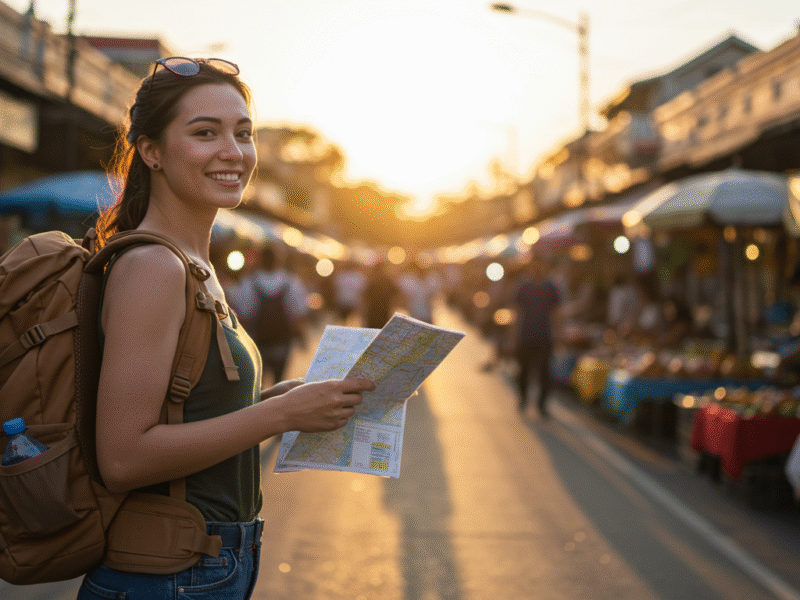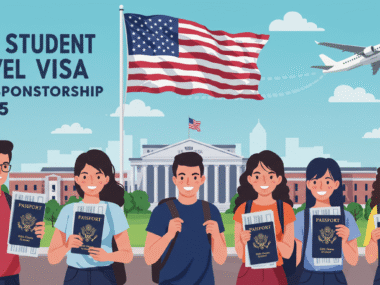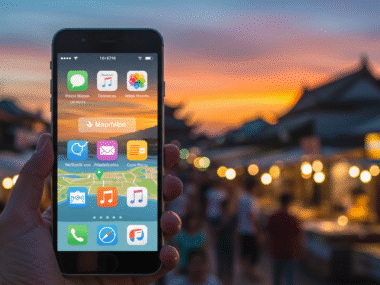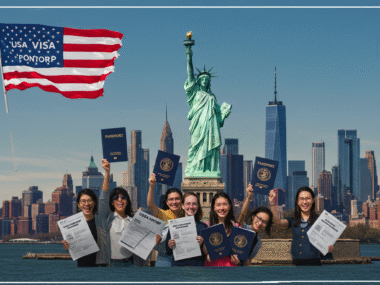Imagine stepping into a bustling foreign market, the air thick with exotic spices and the hum of unfamiliar languages, all while knowing you’re navigating this adventure completely on your own—it’s thrilling, but staying safe should always be your top priority.
Traveling solo can be one of the most empowering experiences in life. It gives you the freedom to explore at your own pace, make spontaneous decisions, and truly connect with new places and people. But with that independence comes the responsibility to protect yourself from potential risks. Whether you’re a seasoned wanderer or planning your first solo trip, understanding how to stay safe while traveling alone is essential. In this guide, we’ll cover everything from pre-trip planning to on-the-ground strategies, helping you enjoy your journey with peace of mind.
Why Solo Travel Safety Matters More Than Ever
In today’s world, where social media showcases glamorous solo adventures, it’s easy to overlook the realities. Statistics show that solo travelers, especially women, face unique challenges like theft, harassment, or health issues in unfamiliar environments. But don’t let that deter you. With smart preparation, you can minimize risks and maximize enjoyment. Think of safety as your invisible travel companion—always there, quietly ensuring you return home with amazing stories.
First off, mindset plays a huge role. Approach your trip with confidence but not overconfidence. Trust your instincts; if something feels off, it probably is. I’ve learned this the hard way on a backpacking trip through Europe years ago. I ignored a gut feeling about a shady alley and ended up losing my wallet. Lesson learned: always listen to that inner voice.
Read Also:
Planning Your Solo Trip: The Foundation of Safety
Before you even book a flight, solid planning sets the stage for a secure adventure. Start by researching your destination thoroughly. Look into crime rates, political stability, and cultural norms. Websites like the U.S. State Department or equivalent government travel advisories provide up-to-date info on potential hazards, from natural disasters to civil unrest.
Choose destinations known for being solo-friendly. Places like Japan, Iceland, or New Zealand often top lists for safety due to low crime and welcoming locals. If you’re a beginner, opt for countries with good infrastructure and English-speaking populations to ease navigation.
Budget wisely, too. Allocate funds for emergencies—aim for at least 20% extra in your travel budget. This covers unexpected medical costs or last-minute changes. Speaking of money, diversify how you carry it. Use a mix of cash, credit cards, and digital wallets to avoid being stranded if one gets compromised.
Securing Travel Insurance: A Non-Negotiable Step
One of the smartest moves for solo travelers is getting comprehensive travel insurance. It acts as a safety net for medical emergencies, trip cancellations, or lost belongings. Look for policies that cover adventure activities if you’re into hiking or scuba diving. Companies like World Nomads or Allianz offer plans tailored for independent explorers, including 24/7 assistance hotlines.
When selecting insurance, read the fine print. Ensure it includes coverage for pre-existing conditions if applicable, and check limits on valuables. I once had a policy that saved me hundreds when my camera was stolen in Bangkok—proof that skimping here isn’t worth it.
Creating an Itinerary and Sharing It
Map out your route in detail, including accommodations, transportation, and key activities. Use apps like TripIt to organize everything digitally. But don’t keep it to yourself—share copies with trusted family or friends back home. Include contact numbers, flight details, and hotel addresses.
Set up regular check-ins. Agree on a schedule, like texting every evening, so if you miss one, they know to alert authorities. This simple habit can be a lifesaver in remote areas with spotty cell service.
Choosing Safe Accommodations
Where you stay can make or break your safety. Prioritize places with good reviews on platforms like Booking.com or Airbnb. Look for properties with 24-hour front desks, secure locks, and positive feedback from other solo travelers.
Hostels are great for meeting people but choose ones with private rooms if privacy is a concern. For hotels, request rooms on higher floors away from street access. Always check for safety features like peepholes, deadbolts, and in-room safes.
If using homestays or couchsurfing, vet hosts carefully. Read multiple reviews and communicate beforehand to gauge their vibe. Trust platforms with verification systems to add an extra layer of security.
Location Matters: Staying in Safe Neighborhoods
Research neighborhoods before booking. Apps like Google Maps can show you street views and user photos. Avoid areas known for high crime, especially at night. Central locations might cost more but offer better access to public transport and emergency services.
Once there, familiarize yourself with the surroundings. Note the nearest police station, hospital, and embassy. Walking tours or local apps can help you get oriented quickly.
Packing Essentials for Solo Travel Safety
What you pack directly impacts your security. Start with the basics: a sturdy backpack or suitcase with anti-theft features like slash-proof straps and hidden pockets.
Personal Safety Gear
Invest in portable door locks or alarms for extra protection in rooms. A whistle or personal alarm can deter attackers in public. For women, consider items like a doorstop alarm or pepper spray where legal—check regulations for your destination.
Tech gadgets are invaluable. A portable charger keeps your phone alive for navigation and emergencies. Download offline maps via Google Maps or Maps.me. A VPN like ExpressVPN secures your internet on public Wi-Fi, protecting against hackers.
Health and Medical Supplies
Pack a first-aid kit with bandages, pain relievers, and any prescription meds—bring extras in case of delays. Include items for common travel ailments like anti-diarrheal pills or motion sickness remedies.
If you have allergies, carry an EpiPen and translation cards in the local language. Get vaccinated as recommended by the CDC, and consider travel health insurance that covers evacuations.
Documents and Backups
Never travel without copies of your passport, visa, and insurance. Store digital versions in cloud services like Google Drive, accessible from anywhere. Use a money belt for originals to keep them close.
Photocopy important cards and leave one set at home. Apps like LastPass can securely store passwords for quick access.
Transportation Safety Tips for Solo Travelers
Getting around safely is crucial. Research reliable options in advance. In cities, use ride-sharing apps like Uber or local equivalents with tracking features. Verify the driver’s details before entering.
For public transport, stick to well-lit, crowded areas. Avoid empty train cars or buses at odd hours. If driving, rent from reputable companies and get full insurance. Use GPS apps but have a paper map as backup.
Flying Solo: Airport and Flight Safety
Airports can be overwhelming. Arrive early to avoid stress, and keep valuables in carry-on. Use luggage tags with covered contact info to prevent identity theft.
On flights, note emergency exits and follow crew instructions. If connecting, allow buffer time for delays.
Navigating Taxis and Rideshares
Always use licensed taxis from official stands. Note the license plate and share your ride details with someone. Apps add accountability with driver ratings and trip sharing.
In some countries, negotiate fares upfront to avoid scams. If something feels wrong, ask to stop and exit calmly.
On-the-Ground Safety Strategies
Once you’re exploring, stay vigilant without paranoia. Blend in by dressing like locals—avoid flashy jewelry or touristy outfits that scream “target.”
Walk purposefully, even if lost. Use your phone discreetly to check directions. In crowded places, keep bags in front and zipped.
Avoiding Common Scams
Scammers prey on tourists. Beware of “helpful” strangers offering unsolicited advice, which might lead to pickpocketing. Common tricks include fake police demanding fines or distraction techniques like spilling something on you.
Research destination-specific scams. In Paris, watch for ring scams; in Bali, fake tour guides. Politely decline and move on.
Staying Safe at Night
Nighttime requires extra caution. Stick to well-lit main streets and avoid shortcuts. If out late, use rideshares instead of walking. Join group activities or tours for company.
Alcohol can impair judgment—drink moderately and never leave drinks unattended to prevent spiking.
Interacting with Locals and Fellow Travelers
Meeting people is a perk of solo travel, but choose wisely. Start conversations in public places like cafes. Use apps like Meetup for organized events.
For dating or hookups, prioritize safety. Meet in public, inform a friend, and trust your gut. Apps like Bumble have safety features.
Health and Wellness While Traveling Alone
Your physical and mental health are key to safety. Stay hydrated, eat balanced meals, and get enough sleep to keep sharp.
Monitor for signs of illness. Know symptoms of common issues like traveler’s diarrhea or altitude sickness. Carry hand sanitizer and masks if needed.
Mental health matters too. Solo travel can be lonely—combat it by journaling or calling home. Apps like Calm offer meditation for stress.
Dealing with Emergencies
Have a plan. Memorize local emergency numbers—it’s not always 911. Download translation apps like Google Translate for communication barriers.
If robbed, don’t resist—material things are replaceable. Report to police for insurance claims. Embassies can help with lost passports.
For medical emergencies, seek care immediately. Travel insurance often covers upfront costs.
Cultural Sensitivity and Respect
Understanding local customs prevents misunderstandings that could escalate. Research dress codes, greetings, and taboos. In conservative areas, modest clothing reduces unwanted attention.
Respect photography rules—ask permission before snapping people. Learn basic phrases to show effort, building goodwill.
Special Considerations for Solo Female Travelers
Women often face additional risks, but millions travel safely yearly. Dress appropriately to local standards. Use women-only transport options where available, like in India or Japan.
Carry a fake wedding ring if it helps deter advances. Join female-focused communities like Girls LOVE Travel on Facebook for tips.
Trust your intuition on interactions. If harassed, speak firmly and seek help from nearby women or authorities.
Safety for LGBTQ+ Solo Travelers
Research destination attitudes toward LGBTQ+ individuals. Some places are welcoming, like Berlin or San Francisco; others pose risks.
Connect with local communities via apps like Grindr or HER, but meet safely. Pride organizations offer resources.
Budget Travel Safety: Cutting Costs Without Cutting Corners
Affordable travel doesn’t mean risky. Use free walking tours from reputable sites. Hostels with lockers secure belongings cheaply.
Eat street food from busy vendors to avoid illness. Budget apps track spending, preventing financial stress.
Eco-Friendly Safety Practices
Sustainable travel enhances safety. Support eco-tourism that benefits communities, reducing resentment toward tourists.
Use reusable items to minimize waste, and choose operators with safety certifications.
Technology’s Role in Solo Travel Safety
Apps are game-changers. bSafe shares your location in real-time. Find My Friends lets loved ones track you.
Wearables like Apple Watch have SOS features. But don’t rely solely on tech—have backups.
Learning from Others: Real Solo Travel Stories
Hearing experiences helps. A friend in Vietnam avoided a scam by recalling online warnings. Another used hotel safes religiously after a theft story.
Forums like Reddit’s r/solotravel offer invaluable advice. Engage but verify info.
Post-Trip Reflection: Improving Future Safety
After returning, review what worked. Adjust for next trips. Share your tips to help others.
Solo travel builds resilience. Each journey teaches new safety lessons.
In wrapping up, remember that staying safe while traveling alone is about preparation, awareness, and trust in yourself. You’ve got this—go make those memories.
For more in-depth resources, check out the U.S. Department of State Travel Advisories or explore safety gear at REI’s travel safety section.











